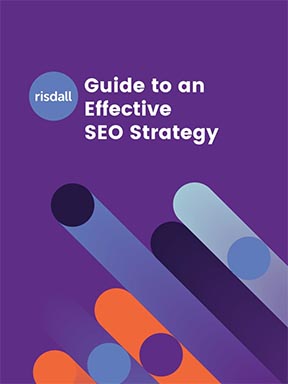The universe in which we draw our target terms is referred to as the keyword universe, and it can be very large. Therefore, choosing the appropriate terms comes down to 4 key considerations:
- How the key term aligns with your business’s offerings
- How the key term aligns with the searcher’s intent and context
- The potential volume of search traffic
- The level of ranking difficulty
You must choose the wording most aligned with your customer’s language and not your own. Also, consider the intention behind those keywords. Taking the time to research your customer’s common search terms will ensure that you secure the most relevant keywords. The keyword universe may be vast, but your SEO strategy will act as a filter for it. Remember that you are not trying to target anything outside of your customer’s most relevant keywords.
Your keyword strategy should focus on “head terms”. Head terms are high-volume, 1 or 2-word keywords. They are the most difficult to rank for and the traffic that results from these tends to be fairly general in audience. After establishing your head term, start researching longer, more nuanced phrases around that term. Those with 2-3 words are called “body” keywords and 3+ words are called “long-tail” keywords.
Examples of Head, Body & Long-Tail Keywords
Head: Clock Radio
Body: Clock Radio iPhone
Tail: Clock Radio with iPhone Wireless Charger
Head: Financial services
Body: Retirement financial services
Tail: Financial services for retirement planning
As you can see, the more words a search query has, the more specific the searcher’s intent. As a result, the more relevant your website content will be to the searchers intent. The search volume for tail terms is much much lower, but the searcher is likely a more qualified prospect.
After assembling your keyword universe, it is time to align these terms with your content marketing plan.
The Keyword Universe & Your SEO Plan
To rank a webpage for a keyword, you have to have content published around that term. SEO only exists in what search engines can read from your website.
When defining your SEO plans, you will need your defined keywords as a starting point for topic generation. The most effective approach that will have the most impact is the hub and spoke model.
Hub & Spoke Model
The hub and spoke model of SEO is the practice of clustering content topics around a central theme. The central theme (head or body keyword) is the hub, supported by several related content pieces. The goal of the model it to become an authority for the hub term. And to do that, you must thoroughly explain the subject and answer the questions of searchers.
Even if a subtopic doesn’t exactly match your product or service offerings, you are trying to build your overall authority.
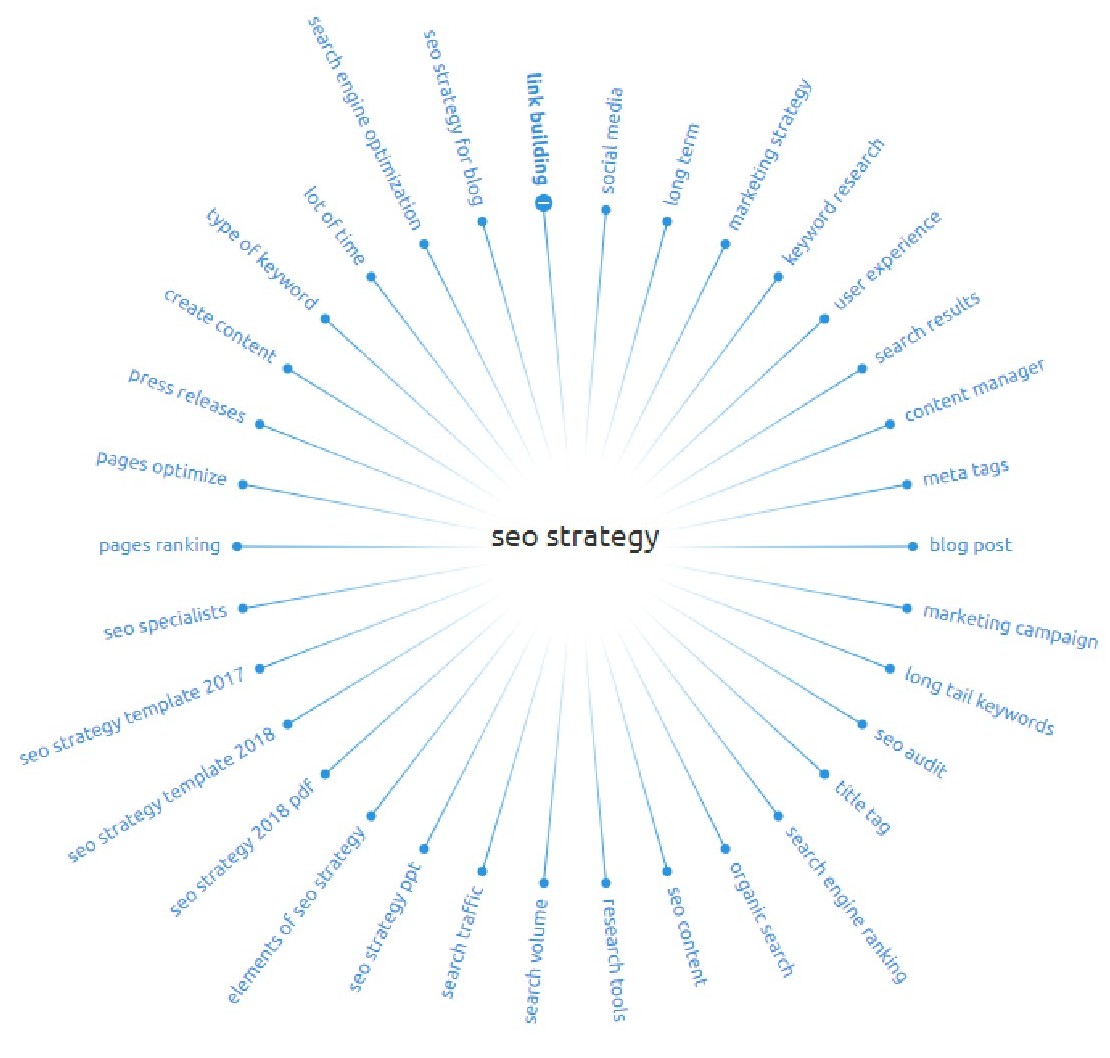
SEO Tools & Keyword Research
When generating topics for your model, keyword research can help be your guide. You can use Google’s own real-time search suggestions to get an idea of what people are searching for around your search term.
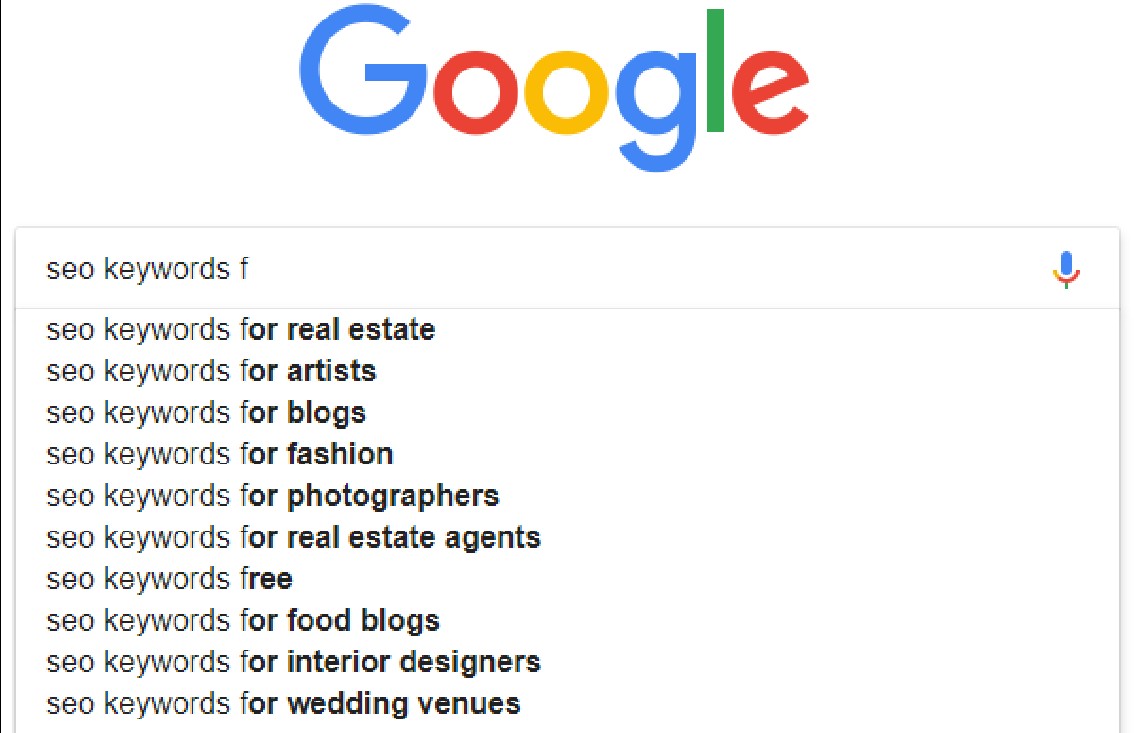
The keyword universe provides a lot of information, so it’s important to use tools to navigate that information. Tools, like SEMRush, BrightEdge, Moz and Answer the Public can find questions around a term. (But that’s a topic for another blog post.)
Sometimes it may be helpful to write a very big, comprehensive piece on your hub topic. Then take that long-form content, break it into smaller chunks, and publish those. Smaller chunks of the larger piece can be published in multiple formats and on different channels.
Any time you can write long-form content and repackage and republish parts, you are saving yourself time and getting maximum value out of your investment, and as a result, you will improve your rankings for those terms.
SEO, Content Marketing, and Website Structure
With your content marketing plan defined, determining how it fits into your website structure can be a bit confusing. Websites don’t exactly follow a hub and spoke model, websites follow a hierarchical model. Hub pages should connect content from across the website, no matter where it resides. Related content like blog posts, product pages, and press releases should all be referenced from the hub page. You must cross-link your supporting content to your hub pages, and vice versa. This will help pass authority from one page to the next.
Let us give you what you need to create an effective SEO strategy for your B2B website! Contact our team to learn more.
As with any marketing or business strategy, having some defined goals and objectives can help keep you focused on the right path along your optimization journey.
Along the journey you will often be presented with choices. When presented with any choice, always choose the one that helps inch you towards a goal.
Website Goals
What is the purpose of the website?
This is a question I usually ask when assessing websites for the first time. For me, it should be obvious. Crystal clear positioning, strong calls to action and well defined content paths (landing page > blog > resource > conversion etc etc).
Conversion Goals
The overall goal of any website would be to drive business. Typically that process is several steps (see customer journey map) or micro-conversions.
For e-commerce retailers, the transaction is the ultimate goal. For other websites (B2B, informational, content publishers, SAAS etc) the goals would likely be driving the prospect down the funnel.
Here are some general conversions you likely would track:
Top funnel conversions:
- Content consumption
- Asset downloads (infographics)
- Subscribe to content (newsletter, podcast, video series)
Mid funnel conversions:
- Resource downloads (whitepapers, ebooks, case study, checklist etc)
- Quizzes and surveys
- Webinars
- Events
- Catalogue
- Tripwire offer
Bottom funnel conversions:
- Product demo or free trial
- Pricing or spec sheets
- Product detail pages
- Contact (speak to a rep/ find a distributor / quote request)
SEO KPIs
Your SEO program goals will always start off being more general. Do not arbitrarily set performance goals like “increase organic traffic by 1000 views per month”.
For one thing, you need time to establish a solid baseline. That means that your analytics has to be configured correctly and collecting data for a reasonable amount of time.
What are good SEO goals to start with:
- Increase overall non-branded keyword rankings
- Increase ranking around a topic (multiple keywords)
- Remove roadblocks for search engines
- Decrease website errors (ex: 404)
- Maximize website performance
Once your site has been optimized, everything configured correctly and your content is in alignment with your keywords, you can start being more specific with your SEO goals. Once established, here are some other metrics that you can start to work on:
- Click-through-rate (CTR)
- Session Duration
- Bounce & Exit Rate
- Organic Impressions
- Organic Conversions
- Referral Traffic
There are a lot more goals & SEO KPI’s that can be layered in, as well as some that may be event or seasonal. To determine the specific goals and KPIs for your business, it’s best to partner with a digital marketing agency such as Risdall.
Risdall’s Guide to an Effective SEO Strategy explains the main concepts everyone should understand about SEO and the essential components that should be in every SEO plan. Click here to download your copy.
Part of any sensible SEO strategy is a firm understanding of your current “state of affairs”. The most effective way to determine your current standing is to conduct an SEO audit.
Why is this important? Well, you may uncover some technical roadblocks on your website that could take time and money to resolve. Furthermore, you could discover that your current SEO strategy is not performing as well as it could. It’s better to find out if there are issues upfront rather than waiting until after executing your plan.
SEO Audit Tools
There are incredibly robust SEO tools that can help you not only conduct your SEO audit but also help to understand the most effective steps to take to improve your SEO. While an SEO audit can be time-consuming and complicated, this process has been greatly improved by the use of SEO tools and services. These SEO tools can crawl your site look for known technical issues, and report back.
Most tools will report some sort of grade and give you a prioritized list of issues to fix.
Some great tools Risdall uses for website audits include:
- BrightEdge
- SEMRush
- Ahrefs
- MOZ
- Serpstat
- Screaming Frog
- Sitebulb
- Varvys
- Builtwith
- GTMetrix
- Google Lighthouse
The more premium tools frequently offer keyword research tools and competitor insights. Another key feature of a quality SEO tool is the ability to monitor your keyword rankings across search platforms. You’ll want to measure and monitor your impact on both technical and content optimizations.
The best tools can integrate into your existing Google Analytics and Search Console accounts. This will allow for more precise reporting and the ability to aggregate different metrics from various sources.
Keyword Rankings and Search Results
Ask yourself these three questions:
- Do you know what you currently rank for?
- Are these rankings in alignment with your audience and business goals?
- Do you have pages that are not being indexed that should?
To determine your current keywords, some of the above mentioned tools can analyze your current visibility.
Another key observation is the number of pages you are currently ranking for. This is easily accomplished by turning the search engine on your site. Type this into the search bar “site:yoursite.com“.
This will give an idea of how many of your pages are in Google’s index. Does the number seem high, low or just about right?
Google Tools Audit
Ensuring that your suite of Google tools are properly configured is the most crucial step in an SEO strategy. You must ensure that analytics is properly configured, the website has been submitted to Google and that you are taking advantage of tag management.
Remember: Google’s tools are very powerful, but out of the box they are set in a one-size-fits-all configuration. Like any tool, they need to be setup by experts and tailored to your website, audience and traffic.
Google Analytics Configuration Questions:
- Are you filtering out your own traffic?
- Are you filtering out your vendors traffic?
- Are you filtering spam/bot traffic?
- Are you excluding self-referrals?
- Are you excluding spam referrals?
- Are your audiences segmented?
- Are goal conversions setup?
- Is site search enabled?
- Is your AdWords account linked?
- Is Google Search Console linked?
- Are content groups enabled and correct?
- Is tracking code implemented properly?
Google Search Console Questions:
- Are https and www/ non-www versions setup?
- Sitemap submitted?
- Robots.txt file submitted?
- Is the website verified?
- Any crawl errors?
- Are resources blocked?
- Are there security or malware issues?
- Are there 404 errors?
Google Tag Manager Questions
- Is GTM installed?
- What tags are implemented and are they firing correctly?
- What events are being tracked?
- Is data being pushed to the data layer correctly?
- Is analytics implemented through GTM?
Unsure of where to start? Let us help! We provide clients with expert SEO services including SEO audits, optimization support, and more.
Who is coming to your website?
More importantly, who do you want to come to your website?
Having a clear understanding on who your prospect and what their search-intent and context is FUNDAMENTAL to driving the kind of traffic that is meaningful towards your goals.
We like to call SEO “intent based search optimization” (IBSO). What “IBSO” is really about is defining what is the prospect searching for at each stage of their journey, and which asset on what channel will satisfy that search.
- Intent – What is the prospect searching for?
- Context – Why are they searching for it?
- Asset – What assets will satisfy their search?
- Channel – Where should their assets live?
- Optimization – How will the prospect find the asset
- Ascension – What is the next step in the customer journey?
To really have a sound platform to work off, you ideally would have well defined customer personas and a customer journey map.
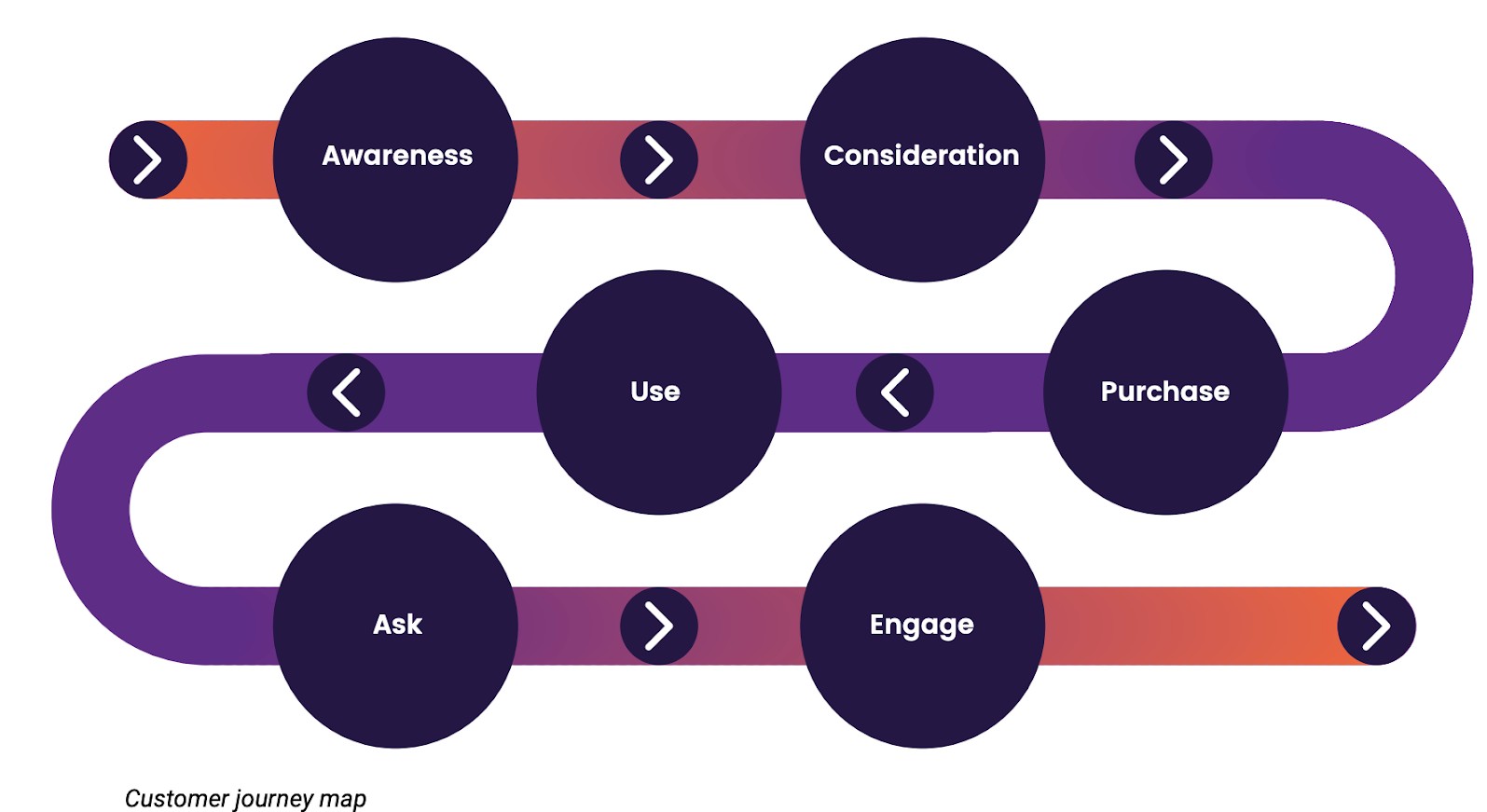
Defining the intent and path of your audience will ensure web users will find your site, find what they want on your site, and (ideally) buy your product or service. It’s important to note that user paths and intent is an evolving concept and should be reviewed on a regular basis.
Risdall’s Guide to an Effective SEO Strategy will explain the main concepts everyone should understand about SEO and the essential components that should be in every SEO plan.
In an ever-changing landscape of best practices, tools, and marketing services, Google algorithm updates can quickly become overwhelming to marketers to choose where to begin SEO and what areas to focus on for the best ROI.
Before embarking on any SEO tactics, having a sound strategy can help define a path and expected outcomes. A comprehensive SEO strategy should include the following items.
SEO Strategy & Planning
- Audience Definition – Who is coming to your website? More importantly, who do you want to come to your website?
- Website, Rankings & Google Tools Audit – Part of a sensible SEO strategy will be a firm understanding on your current state of affairs.
- Goals & Objectives – Having defined goals and objectives can help keep you focused on the right path along your optimization journey.
- Competitor Landscape – Having an eye on competitors also allows you to benchmark your SEO performance, plan content effectively and discover new challengers.
- The Keyword Universe – The universe in which we draw our target terms can be very large. Choosing the appropriate terms is essential.
- Content Marketing Plan – SEO only exists in what search engines can read from your website. To rank a webpage for a keyword, you have to have content published around that term.
- Local SEO (if applicable) – If your business has one or more physical locations where customers would visit to engage with you, then local SEO is another layer of needed optimization.
After the Strategy & Planning portion of a program, you naturally dive into tactical execution:
SEO Execution
- Technical SEO – Website and server optimizations that can be executed to improve your results within search engines.
- Offsite SEO – Offsite SEO or off-page SEO refers to listings and linkbacks outside of your website that will still impact your search engine results.
- Local SEO (if applicable)
- Content Development
- Measurement
- Refinement
What isn’t SEO Strategy?
Many other disciplines are sometimes lumped in with SEO. Digital marketing is a large umbrella, and while SEO falls under that, it is easy to confuse related subjects.
Here are things that fall under digital marketing that are not SEO:
- Conversion Rate Optimization
- Social Media Strategy
- PPC Advertising
- Marketing Automation
Risdall’s guide to an Effective SEO Strategy will explain the main concepts everyone should understand about SEO and the essential components that should be in every SEO plan.
Click here to download the eBook and talk with our team about optimizing your SEO efforts!
Our VP of Digital Strategy, Erik Hinds, attended the Transformation of Search Summit in New York City, and came back with a number of great takeaways. We’ll be putting this knowledge to use immediately for our clients, and wanted to share a distilled version of what was covered.
Takeaway 1: Search = Gratification
Nowadays, search is simply about delivering instant gratification. Customers expect to be able to find what they need quickly, whether it’s content, pictures, videos or other media.
This lesson has to apply to websites, too. Sites must be fast and deliver exactly what the customer is looking for. In fact, it’s expected that by 2020, customer experience will overtake price and product as the key brand differentiator.
While organic SEO is essential, companies should also be supplementing with paid search. You have to do what it takes to get in front of someone, get them to your site and cookie them. Grabbing the top paid and top organic search positions is a major brand-awareness driver.
Furthermore, the search engine results page (SERP) is constantly changing. Just because you own a top organic spot now doesn’t mean it’s yours forever. Google has proven to be a disruptor with algorithm updates and new SERP features.
Takeaway 2: The Future of ecommerce is Visual
It’s estimated that people retain 10 percent of what they hear, 20 percent of what they read, and 80 percent of what they see. Successful digital-born brands are building real experiences with physical stores, such as Casper Mattresses and Amazon opening physical pop-up shops. Even when thinking about digital marketing, it’s essential to consider the physical elements of your presence.
Brand loyalty is declining and buyers rely on the new digital, non-linear path to purchase. Intercepting these buyers at multiple stages of the purchase journey is imperative.
Using platforms like Pinterest, you can reach buyers very early in the planning stages. Did you know that many people start planning Thanksgiving gatherings during the 4th of July holiday?
Takeaway 3: Optimize your Content on YouTube
Listed as the number one online channel for Generation Z, surpassing even Netflix, all ages of users regularly visit YouTube. With 1.9 billion users a month, YouTube accounts for approximately one-third of all internet usage. And while many companies actively utilize YouTube as a marketing platform, very few invest in optimizing their video content.
When planning and creating content for YouTube, it’s important to focus on what your users want and the problems they’re trying to solve. Remember, they’re probably not on YouTube to learn more about your company; they’re looking for specific information that can help in a specific situation. Research what your competitors are doing, and more specifically, what’s working for them and getting the most views.
Make sure you’re using the right keywords and video optimizations. This includes title description, filename, tags, closed captioning and transcripts. All this relates directly to how users will find your content and how you rank against the competition. Most importantly, measure your results utilizing YouTube analytics and keep moving forward with continuous refinement and optimization.
Risdall can help make sure you’re ahead of the curve as search continues to transform, even if you’re just getting started. Contact [email protected] to schedule a call with one of our search experts to ensure you survive, and thrive, in today’s competitive online marketplace.
It’s a pretty safe guess that most business professionals are familiar with the concept of Search Engine Optimization (SEO). But after that, SEO is an enigma that we all know is important, but we either hand it off to someone else or we completely ignore it.
When Risdall originally put together our Guide to an Effective SEO Strategy, the goal was to demystify SEO and break-down effective SEO strategy into several main areas. While most companies will want to work with an experienced SEO partner, there are methods and activities everyone can do to improve how search engines are reading (and finding) your website.
Ultimately, every company should have a proactive SEO strategy, not to mention a dedicated budget, but Risdall’s Guide to an Effective SEO Strategy will explain the main concepts everyone should understand about SEO and the essential components that should be in every SEO plan.
Click here to download the eBook.
Google Optimize, a website optimization tool included in the Google Marketing Platform, has been used by thousands of webmasters to conduct A/B testing and improvement tracking. These features have proven invaluable to businesses, allowing for targeted experiments aimed at improving user experience and website performance. Google has now added personalization features, narrowing the capabilities gap between this free tool and commercial competitors.
The new personalization features can be used as a means to deploy a winning A/B experiment version or as a standalone feature to personalize content. In previous versions of “Optimize”, marketers had to manually deploy a winning experiment as a code or data change, or deploy as a separate experiment that targeted all users since Optimize does not allow changes to experiments once started. Similarly, personalizing content was a workaround at best. Targeting options for personalization in the free version of Google Optimize have steadily improved. They include mainstays like URL, referrer, cookie value, and device type, as well as some slick integrations with other Google Marketing Platform data such as Geography (using the Google Ads Geo Targeting API), Ad Groups, and Google Tag Manager data layer variables. Targeting by Analytics Audiences is still reserved for the paid version, Optimize 360.
A Word of Caution
We strongly recommend partnering with an experienced professional when setting up Google Optimize. While it’s possible to deploy the Optimize plugin via tag management solutions alone, it’s not recommended and will likely result in increased load time and the user experience nightmare known as the Flicker of Original Content (FoOC), when an original page is briefly displayed before the alternative appears. Poor implementation may lead to conflicts with tagging, analytics, and other JavaScript based libraries. In short, the byproducts of poor implementation are the opposite of the platform’s intent.
Other Options
Google is not the only solution for A/B testing and content personalization. VWO has been offering A/B and personalization for several years now. Optimizely is another option, albeit at a premium price.
On the enterprise end of the spectrum, all-in-one solutions such as Adobe Experience Platform and SalesForce Marketing Cloud have these features baked in, but are saddled with other modules which may not be necessary.
Contact us today to talk more about how we can optimize your website and apps to make sure they’re allowing a personalized experience for every visitor and customer.
User Experience
Getting information to your users faster is always better. Page speed scores may appear to be an arbitrary number that have more to do with the underlying technologies of a webpage, but improving them will automatically improve the experience for your users. Because more and more people have access to broadband connections and faster mobile speeds, when a page loads slowly it is far more obvious than it used to be. You can see how quickly users will drop a page in this infographic provided by Google from their own research: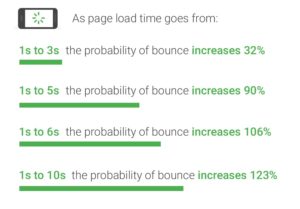
Additionally, users that experience a noticeably slow page are less likely to return to that site in the future. A slow site can give the impression that it is untrustworthy, which will also affect the likelihood of a user returning to the site.
Better Conversions
Research by Kissmetrics has shown that 40 percent of users will abandon a page that takes more than three seconds to load. This means that if you have a slow loading page, you could be losing a significant percentage of your conversions before they’ve even had a chance to view the page.
For e-commerce the difference can be even more distinct. Walmart demonstrated a 2 percent increase in their conversions for every one second improvement that they made to their page speed. They also showed a direct correlation between bounce rate and site speed: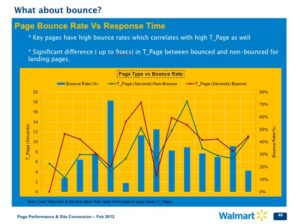
Improved Indexing
In 2010, Google Announced that page speed had become a ranking factor for websites. While having a fast site doesn’t automatically mean that you will rank higher than other sites with similar content, but it does mean you won’t be penalized for having a slow site.
In addition, when your site is being crawled by bots such as Google there is a factor that determines how quickly the indexing occurs. This is commonly referred to as Crawl Budget. According to Google:
“If the site responds really quickly for a while, the limit goes up, meaning more connections can be used to crawl. If the site slows down or responds with server errors, the limit goes down and Googlebot crawls less.”
What this means is that when your site is faster, the Googlebot is able to index more pages within its allotted crawl budget, which then helps your site content become indexed quicker.
Conclusion
Based on a number of factors outlined, there are direct, measurable benefits to improving your page speed. Make sure to check back for the final article in this series where we’ll cover ways that you can improve your site’s page speed without sacrificing the user experience or content quality.
Wondering where your website falls on the speed scale? Contact us today for a free assessment.
Google constantly updates their algorithm, which can have drastic effects on your rankings.
If you are running a modern digital marketing program, then organic search position is likely very important to attracting new business with the highest return on investment (ROI.)
Google is constantly tweaking the ranking factors, and sometimes they go beyond just little tweaks. Some changes are what they call a “broad core algorithm update.”
This week we released a broad core algorithm update, as we do several times per year. Our guidance about such updates remains the same as in March, as we covered here: https://t.co/uPlEdSLHoX
— Google SearchLiaison (@searchliaison) August 1, 2018
These major updates occur several times a year. Sometimes, you may be a beneficiary of a big boost in search rankings and an influx of traffic.
You’ll ride their wave and this update could propel you forward.
Other times, your rankings significantly change for the worse. Your SEO ship has capsized.
Great Poseidon! Why do they do this?
Google continues to refine its algorithms over time so it can be a better search engine for users. Their goal is to get the most relevant results to the searcher.
Keep in mind that the way people are searching and the types of results served are also evolving. For example, over the last few years we have seen a big jump in mobile queries and voice search.
Google is constantly pulling data, figuring out which results generated in clicks and which did not. Trends are noticed and adjustments are made.
Monitoring the High Seas
So, how do we know when one of these waves of change to search engine results pages (SERP) will come crashing down? We don’t. Ever.
Unfortunately, Google does not send out a fair warning ahead of time. If you are diligent and check every day, you can use several tools to track SERP volatility
SEMRush
SEMRush provides a free volatility monitor showing major and minor updates. They also categorize the winners and losers from major updates.
https://www.semrush.com/sensor
SEMRush has premium options available for deeper insights.
RankRanger
RankRanger also monitors Google SERP fluctuations. We always recommend checking multiple sources to confirm index volatility.
https://www.rankranger.com/rank-risk-index
BrightEdge
While BrightEdge does not monitor SERP volatility, it does monitor keyword positions and can alert you to anomalies (both good and bad).
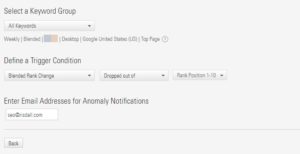
We’re Going to Need a Bigger Boat
Q: How do I fix my rankings after an algorithm update?
A: There is no fix, per se. What you should focus on is creating top notch content that fits your target’s needs while following SEO & web dev best practices.
According to Google…
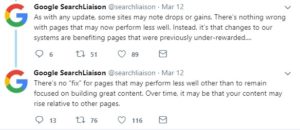
The best thing you can do is build a solid ship to carry you across the search ocean. The foundation of the ship is built on best practices: secure, mobile friendly, page speed, page titles, links, etc.
Content will be the engine that drives your ship. The more quality content you feed the ship, the better position you’ll be in.
Do you need some help navigating the rough waters of SEO, content development and website best practices? Let our team help!
Have you ever experienced a webpage that took too long to load? Remember how frustrating that was? Well, you’re not alone. How fast (or slow) a page loads is a major contributing factor to page abandonment, and it plays an important role in your website’s SEO rankings, user experience and overall functionality.

According to surveys done by Akamai and Gomez.com, 40 percent of people will abandon a website that takes more than three seconds to load. For e-commerce sites, 52 percent of online shoppers state that quick page loading is important to their site loyalty.
This is the first in a series of posts focused on page speed. The following two posts in this series will cover why it’s important as well as some basic tips to improve your own page speed.
What is page speed?
Page speed is the amount of time it takes for a web page to become visible and fully interactive by a user. There are a few different metrics that are commonly used to measure this:
First Meaningful Paint
First meaningful paint is the first point that the page’s primary, above-the-fold content becomes visible. This can include any styles, fonts, or images that are critical to the display of the page. For example, if you’re using a custom web font for your page text and you’re not loading the font asynchronously, the first meaningful paint would not occur until that font has been loaded and appears on the page.
This is typically the most important of the metrics as it is directly visible to the user. If you reduce your first meaningful paint time from three seconds to 1.5 seconds, that is an obvious change that your users will experience.
First Interactive
First interactive is when the page has become minimally interactive for the user. Most, but not necessarily all, elements on the page are interactive and the page responds, on average, to most user input.
Consistently Interactive
A page would be consistently interactive when all functionality is available to user and there are no more than two active network connections in process. This would be when all interactive elements on the page that are part of the initial load have finished downloading and processing and are fully rendered.
By combining these three measurements we can get a good idea of how fast a page appears to load for the average user. When measuring these speeds it’s important to remember that not every user is going to have the same connection speed as you. For example, Google predicts that 70% of cellular network connections globally will occur at 3G or slower speeds through 2020. This is also the standard that Google uses to determine your site’s page speed score.
Part two of the Page Speed series answers the question why your page speed is so important.
Interested in your website’s page speeds? Contact us today for a free assessment.
-Khan to lead charge in digital solutions as SVP Digital Media and Analytics-

ROSEVILLE MINN. (August 15, 2017) – Risdall is excited to continue the expansion of its digital marketing capabilities with the addition of Mahmood Khan as Senior Vice President of Digital Media and Analytics. Khan joins Risdall from Periscope where he served as the Director of Media and Analytics and led a team of digital media, paid search and SEO professionals. Prior to Periscope, he led international ecommerce campaigns for clients at Digital River. Khan currently serves as a Member of IAB Digital Media Buyer and Planner Certification Program Exam Committee which sets the standard for global certification. Khan will lead digital initiatives with a passionate data-driven perspective and his extensive expertise builds on Risdall’s integrated model of digital platform development, digital content marketing and communications, paid engagement and analytics.
In joining Risdall, Khan said, “The advanced web development and app development capabilities Risdall already possesses will easily integrate with the best practices and disciplines I am bringing and ultimately result in a very integrated digital solution for clients.”
“We are very excited about Mahmood joining the team,’ said Ted Risdall, Chairman and CEO of Risdall. “His knowledge and high level of expertise with national and global initiatives will help Risdall lead clients to live fully and effectively in the digital world and enable us to deliver business results that matter.”
About Risdall
Risdall is a full-service integrated digital marketing agency. For 45 years, Risdall’s marketing, communications and digital capabilities have constantly evolved, driven by an independent culture and a commitment to achieving our client’s business goals. For more information visit www.risdall.com
